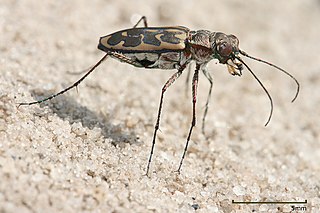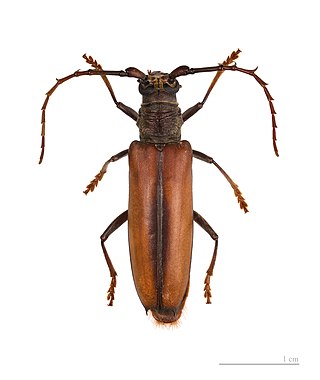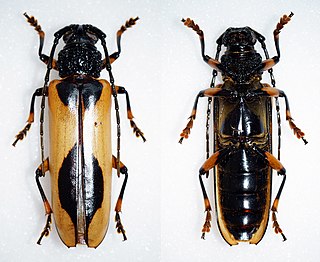
Tiger beetles are a family of beetles, Cicindelidae, known for their aggressive predatory habits and running speed. The fastest known species of tiger beetle, Rivacindela hudsoni, can run at a speed of 9 km/h, or about 125 body lengths per second. As of 2005, about 2,600 species and subspecies were known, with the richest diversity in the Oriental (Indo-Malayan) region, followed by the Neotropics. While historically treated as a subfamily of ground beetles (Carabidae) under the name Cicindelinae, several studies since 2020 indicated that they should be treated as a family, the Cicindelidae, which are a sister group to Carabidae within the Adephaga.

Euprosopus is a genus of tiger beetles. There are at least two described species in Euprosopus, found in Brazil.
Guineica is a genus of tiger beetles. There are at least two described species in Guineica, found in Indonesia, New Guinea, and the Solomon Islands.
Langea is a genus of tiger beetles. There are at least three described species in Langea.
Manautea is a genus of tiger beetles. There are at least four described species in Manautea, found in New Caledonia.
Megalomma is a genus of tiger beetles. There are about five described species in Megalomma.
Neolaphyra is a genus of tiger beetles. There are at least four described species in Neolaphyra, found in North Africa.
Nickerlea is a genus of tiger beetles. There are at least four described species in Nickerlea, found in Australia.
Notospira is a genus of tiger beetles. This genus has a single species, Notospira phalangioides. It is found in Myanmar.
Opisthencentrus is a genus of tiger beetles. This genus has a single species, Opisthencentrus dentipennis. It is found in Brazil.
Orthocindela is a genus of tiger beetles. There are at least two described species in Orthocindela.
Oxygoniola is a genus of tiger beetles. This genus has a single species, Oxygoniola chamaeleon. It is found in Indonesia.
Pometon is a genus of tiger beetles. There are at least two described species in Pometon.
Pronyssiformia is a genus of tiger beetles. This genus has a single species, Pronyssiformia excoffieri. It is found in China.
Salpingophora is a genus of tiger beetles. There are about five described species in Salpingophora.

Criodion is a genus of Long-Horned Beetles in the beetle family Cerambycidae. There are about 11 described species in Criodion.

Hirtobrasilianus is a genus of Long-Horned Beetles in the beetle family Cerambycidae. There are at least three described species in Hirtobrasilianus.

Juiaparus is a genus of Long-Horned Beetles in the beetle family Cerambycidae. There are about five described species in Juiaparus.

Metacriodion is a genus of longhorn beetles in the family Cerambycidae. There are at least two described species in Metacriodion.
Plocaederus is a genus of Long-Horned Beetles in the beetle family Cerambycidae. This genus has a single species, Plocaederus bellator. It is known from the South American countries Brazil, Ecuador, Guyana, French Guiana, Paraguay, and Suriname.




